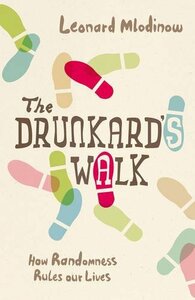Take a photo of a barcode or cover
Fantástica introducción a las matemáticas de la probabilidad y a los miles y miles de casos en nuestra vida en los que se pueden aplicar. Como por ejemplo la reversión a la media, que explica la famosa maldición del Sports Illustrated: cuando un jugador de fútbol americano salía en la portada de la revista, quedaba maldito y sus números empeaoraban a partir de entonces. Esto sucede porque sólo salían en la portada de la revista los jugadores con una racha excepcional de buenos resultados, por lo que lo habitual es que volvieran a un nivel algo más normal de resultados tras salir en la revista. Y así mil casos.
Este es uno de esos libros épicos que nos desvelan algo que siempre ha estado ahí pero que nunca habíamos decubierto. Muy, muy recomendable.
Este es uno de esos libros épicos que nos desvelan algo que siempre ha estado ahí pero que nunca habíamos decubierto. Muy, muy recomendable.
More about statistics than randomness, but interesting nonetheless.
I was really jazzed for this book after reading Feynman’s Rainbow years back. Mlodinow has a rare talent for prose among scientists, and reminded me a bit of the ever sentimental Michael E.Brown.
The only thing is, he didn’t have anything worth writing about here. He made his point by the third chapter, and spent the remainder of the book flogging the same horse. Was it fun? Not really. Did I learn something? Potentially.
The book is just a single run-on sentence, punctuated with facts that feel more like a repertoire of party trivia than of any substantial argument development.
The only thing is, he didn’t have anything worth writing about here. He made his point by the third chapter, and spent the remainder of the book flogging the same horse. Was it fun? Not really. Did I learn something? Potentially.
The book is just a single run-on sentence, punctuated with facts that feel more like a repertoire of party trivia than of any substantial argument development.
This was an intro course in stats, written as a narrative, with a little history thrown in. I might’ve been more interested if I’d read it when I was first learning stats because most of the examples were the pretty standard ones (Monty Hall problem, false positives in HIV testing, the birthday problem, etc).
There were lots of tongue in cheek asides that irritated me and just seemed unnecessary.
In terms of the history, there were a couple (I counted 2) brief nods to non-European mathematics, but really brief ie “the concept of zero came from India. Now let’s talk about the Greeks for a long time.” “Chinese mathematicians actually found the patterns in Pascal’s triangle, but let me tell you about pascal.”
Overall this felt like someone wanted to write a book that sounded like a Radio Lab episode. The benefit of a math book is that it can have non-text representations like graphs and tables to help you understand the content, but those were lacking. So it should’ve been a radio lab episode.
There were lots of tongue in cheek asides that irritated me and just seemed unnecessary.
In terms of the history, there were a couple (I counted 2) brief nods to non-European mathematics, but really brief ie “the concept of zero came from India. Now let’s talk about the Greeks for a long time.” “Chinese mathematicians actually found the patterns in Pascal’s triangle, but let me tell you about pascal.”
Overall this felt like someone wanted to write a book that sounded like a Radio Lab episode. The benefit of a math book is that it can have non-text representations like graphs and tables to help you understand the content, but those were lacking. So it should’ve been a radio lab episode.
A great introduction to randomness and how it affects our lives. If you are familiar with Yuval Harari or Nassim Taleb you will be familiar with some of the concepts in the book, but there is enough extra material to keep this on your reading list. It is a very personal book with a lovely ending. It’s a very readable and accessible book with a light, enjoyable style.
Interesting...and not. Life is random and this shows how we try to make sense out of randomness. I guess I feel very comfortable with that concepts so nothing too revealing.
The drunkard's walk is a remarkable book. It is a journey about the concept of randomness in a very broad way that leads you into the historical path of probability and statistics and through a bunch of other related areas and personalities that with their work or clever questioning were responsible to build the body of scientific work that we currently use. Life of Cardano, Bernoulli, Bayes and others were beautifully drawn in a lovely picture. My background is mathematics and I must confess not a very fan of statistic fields however this book can make anyone fall in love with them. Leonard Mlodinow did an absolutely amazing job in this book.
This is not the type of book I generally read, but I was drawn to the title. I expected this book to be more about the universe and how things just seem to happen but behind it, there are some good reasons. In a sense, it was about that, but in a less spiritual and more mathematical way. The math was a little overwhelming at times, but the writer really does do a great job of making the theories, explanations, and history very accessible. It's not my favorite book, but I think that has more to do with personal taste than actual quality. If you are into logic, this is a great book for you.
Apparently nothing matters and everything is random. Leonard suggests that us humans only notice things happening when they are out of the ordinary and we like to assign meaning to it. Turns out, nope.
A really nice overview of fundamental concepts in probability and statistics, in the context of the lives of the frequently bizarre people who developed them! If you wanted to learn more about this topic, this book would give you a good handle on the concepts so you could dive in and understand your awful textbook full of opaque formulas.
I really enjoyed the descriptions of collaboration and inspiration among the people who made important contributions to probability.
The writing style is overall a bit academic, but still good for a general audience without any background in the subject or extensive practice deciphering universitese. It's pleasant, casual, and the examples are easy to follow.
Where this book falls down a little bit is in guiding you towards applying these concepts to your life or work. I think a reader would need a little more hand-holding and walking through specific scenarios to think about how to use these ideas. We're not likely to be guests on "Let's Make A Deal," so even after working out the awesome and counterintuitive Goat Odds, it would still be hard to go through the same process for scenarios we're likely to encounter in real life. This is where an author like Malcolm Gladwell would really succeed with this kind of material - by coming up with a few good ideas for applications and running with them, stripping them down to their bare essentials and presenting a persuasive argument for how to identify your biases that are based on limited evidence, override your intuition and rely on real measurements of what is likely to occur. Mlodinow tries to advocate for this, but you'd need to develop it on your own, and where's the pop-science fun in that?
I really enjoyed the descriptions of collaboration and inspiration among the people who made important contributions to probability.
The writing style is overall a bit academic, but still good for a general audience without any background in the subject or extensive practice deciphering universitese. It's pleasant, casual, and the examples are easy to follow.
Where this book falls down a little bit is in guiding you towards applying these concepts to your life or work. I think a reader would need a little more hand-holding and walking through specific scenarios to think about how to use these ideas. We're not likely to be guests on "Let's Make A Deal," so even after working out the awesome and counterintuitive Goat Odds, it would still be hard to go through the same process for scenarios we're likely to encounter in real life. This is where an author like Malcolm Gladwell would really succeed with this kind of material - by coming up with a few good ideas for applications and running with them, stripping them down to their bare essentials and presenting a persuasive argument for how to identify your biases that are based on limited evidence, override your intuition and rely on real measurements of what is likely to occur. Mlodinow tries to advocate for this, but you'd need to develop it on your own, and where's the pop-science fun in that?



